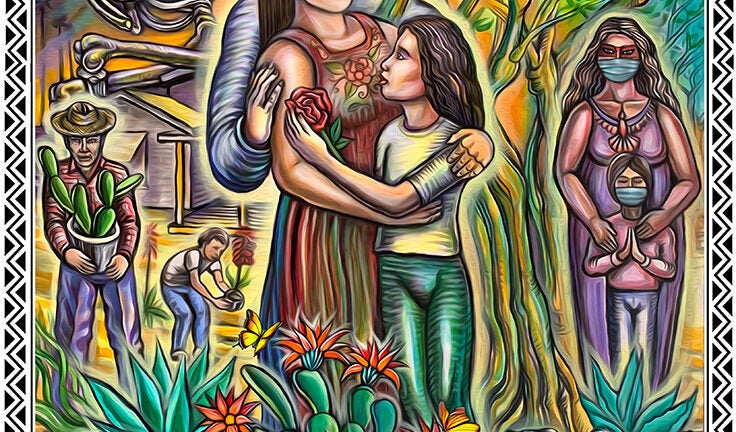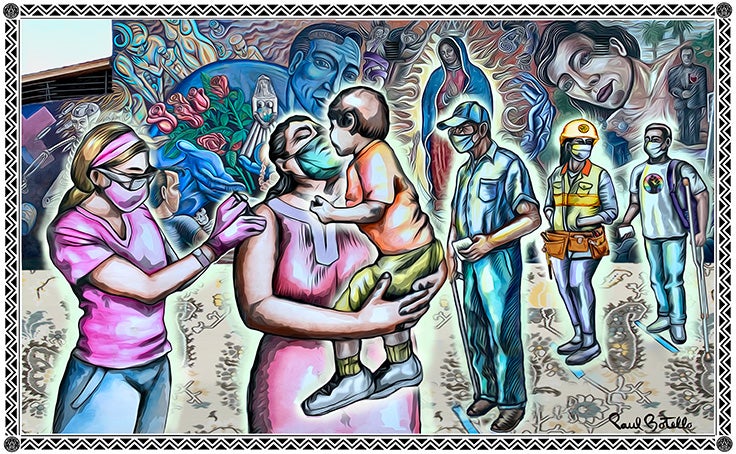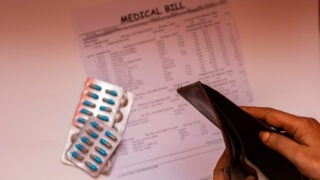
Vulnerable Groups Came First in USC’s COVID-19 Vaccination Efforts
When COVID-19 hit Southern California, Keck Medicine of USC mobilized to protect the hardest-hit, highest-risk communities.
Maria Saravia was so terrified of exposing her parents to COVID-19 that she would shower thoroughly after her shift at the hospital before going home. And that was just the beginning of her ritual.
When she arrived, she would enter through the back door, take off her shoes and head inside. “I’d shower again, put my clothes in a plastic bag, then wash them separately without any clothes from the rest of my family,” Saravia says. “Nobody would talk to me until I was done.”
Saravia, 57, cleaned patients’ rooms for hours on end in the COVID-19 wing at Keck Hospital of USC as a member of the facility’s environmental services staff. Seeing so many patients on ventilators scared her at first. So did having to cover herself with protective gear before entering their rooms. Even when she was vaccinated during the first wave of COVID-19 vaccine clinics for health care workers, she still feared for the health of her elderly parents and other family members in her Boyle Heights community. This working-class, heavily Latino enclave was one of the areas hit hardest by the pandemic.
At the time, vaccine appointments for the public were scarce. But as the pandemic peaked, she got good news: Keck Medicine of USC had prioritized doses for family members of front-line workers who were eligible based on government guidelines. Saravia quickly signed up her parents.
“For me, it was like a blessing,” she says. “I am a privileged woman because I work here.”
Keck Medicine focused first on vaccinating communities most impacted by the pandemic: those most likely to live with essential workers and those often lacking consistent access to health care.
Yet Saravia’s parents received the vaccine precisely because Keck Medicine leaders wanted to overcome privilege. As the USC health system expanded its vaccine outreach during the beginning of the rollout, equity became its guiding principle. Amid high demand for the initial doses, Keck Medicine focused first on vaccinating communities most impacted by the pandemic: those most likely to live with essential workers and those often lacking consistent access to health care.
“I think there’s a moral responsibility,” says Felipe Osorno, executive administrator for continuum of care operations and value improvement. “We’re a huge health care provider, we’re in the middle of Boyle Heights, a predominantly Latino neighborhood, and we looked at the data. We felt it was the right thing to do.”
USC Prioritizes COVID-19 Vaccines for Underserved Communities in L.A.
Saravia had reason to fear for her family’s safety. Grandparents, parents and grandchildren all share the same home, raising the risk of spread. They’re essential workers who can’t work remotely. And they’re Latino—a community with a COVID-19 death rate three times higher than non-Latino white and Asian residents in Los Angeles County.
She felt relieved when Keck Medicine included environmental services staff members alongside doctors, nurses and other health workers in its first round of vaccinations in December 2020. Not all hospitals included their custodial and cleaning teams in that initial wave.
Osorno, though, remembers when vaccination planners prioritized the environmental services staff as they started their rollout. “It was unique among health care systems,” he says. “Everyone else only included clinicians first.”
To further ensure all health workers had equitable access, Keck Medicine sent out information about the vaccination process in multiple languages. “We also realized that most of our communications had been via email until then,” Osorno says. “So we started to hold in-person meetings. I personally talked with the staff in different shifts and answered their questions.”
When California expanded eligibility to people aged 65 or older, the vaccine quickly became a scarce commodity.
When California expanded eligibility to people aged 65 or older, the vaccine quickly became a scarce commodity. Keck Medicine leaders prioritized access for older family members and friends of its health care team, knowing they might not be able to get them otherwise.
Seeing the hospital staff’s elderly relatives lining up for a shot reminded Osorno of his own family back home in Colombia: “To me, it was like seeing my parents and grandparents getting the vaccine.”
USC Community Outreach Brings Vaccines to Angelenos in Need

As more people became eligible for vaccinations, the health system expanded outreach. It partnered with nonprofits and government agencies to vaccinate Angelenos. At one point, Keck Medicine ran a free shuttle from Mariachi Plaza in Boyle Heights for people who had no way to get to vaccine appointments.
The USC School of Pharmacy and USC Pharmacies collaborated with county and city officials, local health insurance organizations and churches to set up community walk-in and drive-thru vaccine clinics throughout Los Angeles. USC also worked with school districts in East Los Angeles to vaccinate teachers. The university launched a vaccination site at Lincoln Park across the street from the USC Health Sciences Campus in Lincoln Heights, another hard-hit community. Keck Medicine offered pickup services for patients who had no access to transportation. Some USC physicians even made house calls to provide vaccines to homebound seniors.
We have and will continue to vaccinate all who are clinically eligible for the COVID-19 vaccine, regardless of factors such as insurance or immigration status.
Michelle Hormozian
“USC Pharmacies held both indoor events and outdoor events, including drive-thru and walk-up COVID-19 vaccine clinics across Los Angeles, with a focus on underserved communities,” says Michelle Hormozian PharmD ’18, clinical coordinator for USC Medical Plaza Pharmacy. “We have and will continue to vaccinate all who are clinically eligible for the COVID-19 vaccine, regardless of factors such as insurance or immigration status.”
The pharmacy school also helped launch the vaccine clinic at Dodger Stadium, one of the largest mass vaccination sites in the country. Volunteers administered 12,000 shots a day there at the peak of the rollout. USC students, faculty and alumni staffed the site from day one.
The impact they made speaks for itself: Of the 1.3 million vaccines that the city of Los Angeles administered by June 1, more than half were delivered at sites and pop-up clinics staffed by Trojans.
Says Richard Dang ’09, PharmD ’13, an assistant professor of clinical pharmacy who helped lead the vaccination effort: “We showed that we can accomplish really big tasks when we work together.”
USC Vaccination Efforts Focus on Vulnerable Groups
To get vaccines to the most vulnerable in Los Angeles, Keck Medicine staff members worked with USC’s community relations team to meet leaders of local churches and community organizations. They built new partnerships with the Ramona Gardens Senior Center, the L.A. County Office of Education and other groups and agencies in East Los Angeles.
About 40 Keck Medicine staff members worked phones, pitched ideas and set up the infrastructure needed to administer the shots. Employees from information technology, ambulatory operations, nursing, marketing, communication, pharmacy and other groups pitched in, Osorno says.
One anecdote, he says, captures the breadth of USC’s impact. L.A. officials identified 128 ZIP codes that were most vulnerable during the pandemic based on health and socioeconomic data. Focusing vaccine efforts in these underserved neighborhoods would be critical. But USC was one step ahead of them: Its health professionals and volunteers already had vaccinated residents from all 128 neighborhoods.
“That was just amazing,” Osorno says.
Now that demand for the COVID-19 vaccine is declining, Keck Medicine is applying lessons learned from the pandemic to other areas, including vaccination efforts linked to the upcoming flu season.
Another related focus: ensuring that patients have equitable access to quality medical care.
A newly launched health equity committee will identify gaps in treatment and care at Keck Medicine based on factors like age, language, race, gender and sexual orientation. “For example, one of the first things we are going to focus on is ensuring that our patients can access care in the language they prefer,” Osorno says.
We have to eradicate this pandemic; we have to protect ourselves.
Maria Saravia
Making systemwide changes to ensure equity will be an ongoing process across USC, but each member of the team plays a role in bridging those gaps. For Saravia, it’s still about protecting her family and community. She encourages her neighbors in Boyle Heights to get the COVID-19 vaccine if they haven’t already.
“You should vaccinate,” she says. “We have to eradicate this pandemic; we have to protect ourselves. I do it principally out of love for my family and my parents because they are high risk and I don’t want them to die on my account. If you have love for yourself, you have love for others.”



